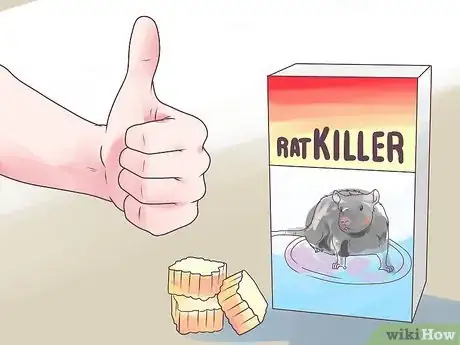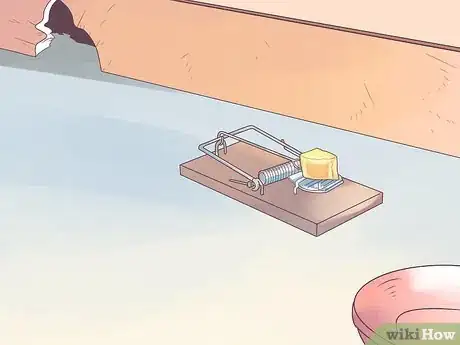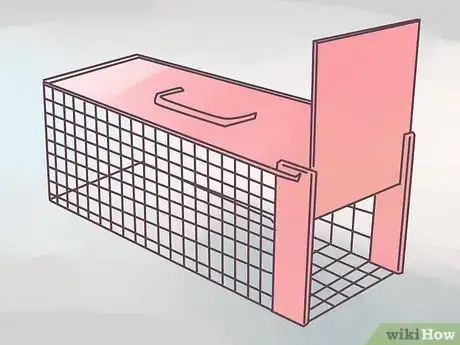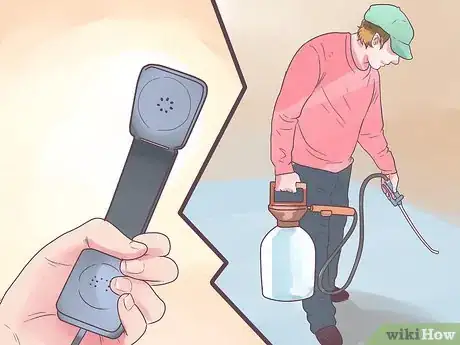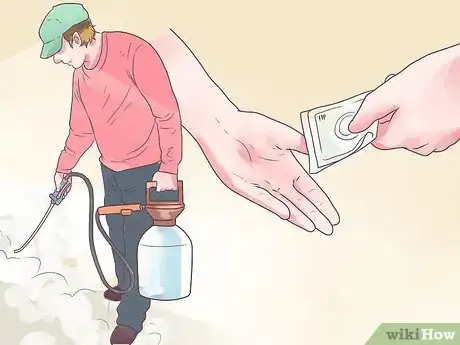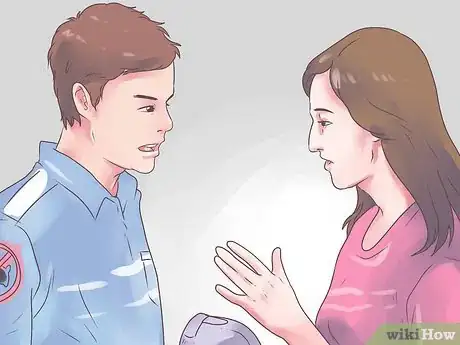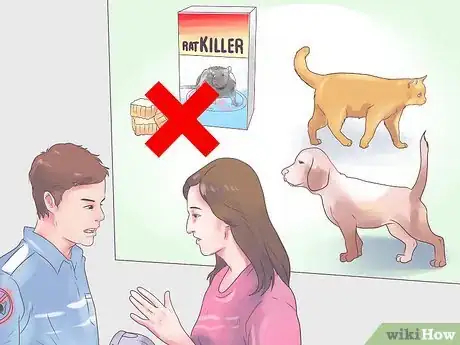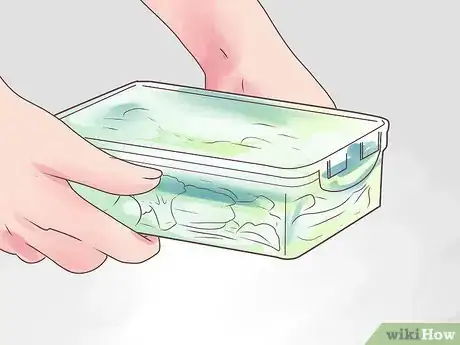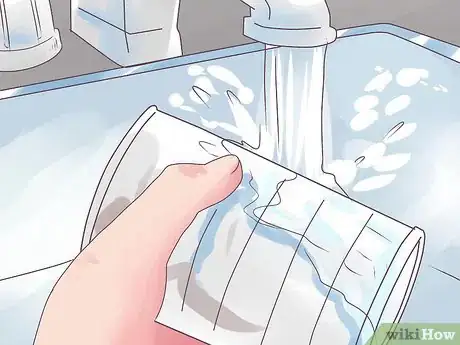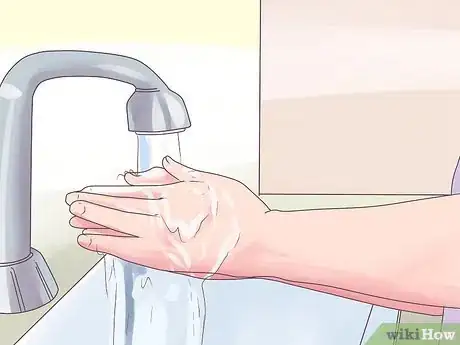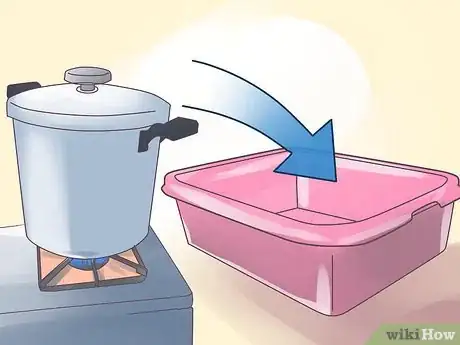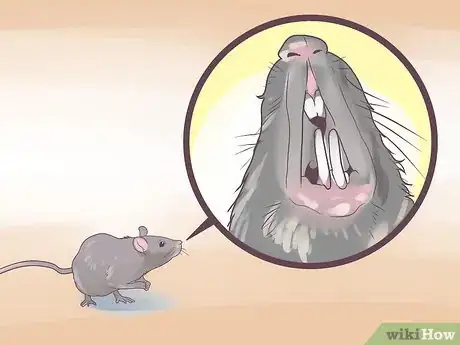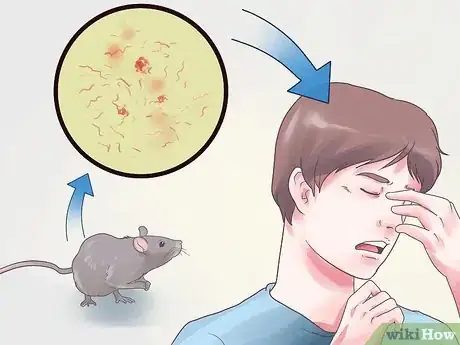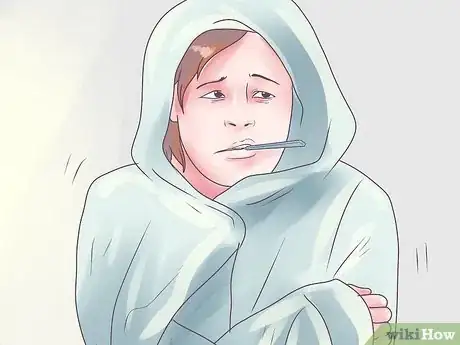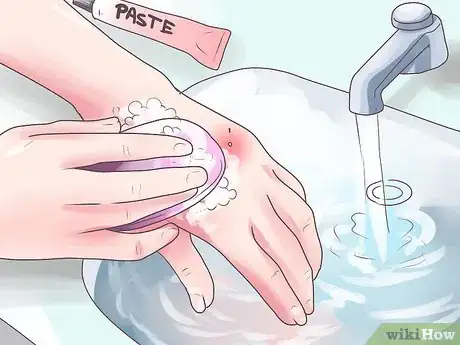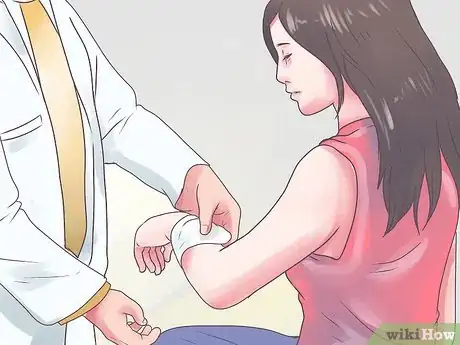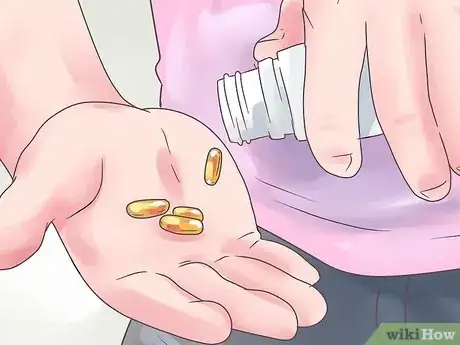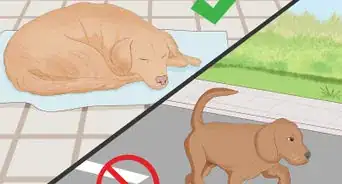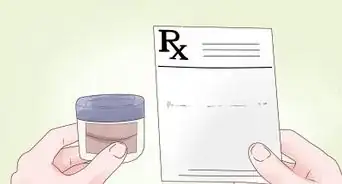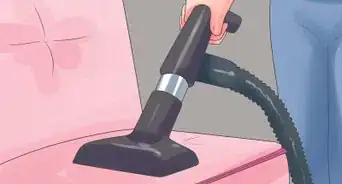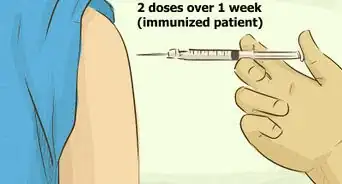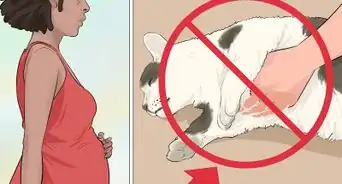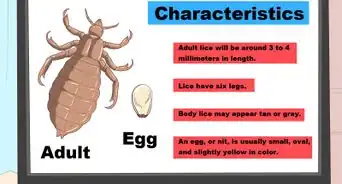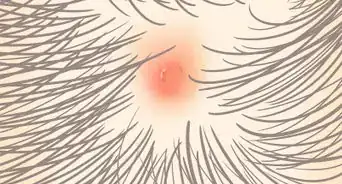This article was co-authored by Chris Parker. Chris Parker is the Founder of Parker Eco Pest Control, a sustainable pest control service in Seattle, Washington. With over seven years of experience, Chris specializes in Integrated Pest Management and doesn’t use any chemicals for pest removal. He offers removal services for ants, rodents, fleas, spiders, wasps, and more. Chris is a certified Commercial Pesticide Applicator in Washington State and received his bachelor’s from the University of Washington.
There are 15 references cited in this article, which can be found at the bottom of the page.
This article has been viewed 36,898 times.
Rat bite fever, as the name suggests, is a disease that you can get if you are bitten or scratched by a rat. You can also contract this disease if you consume contaminated food or water that has come into contact with rat urine or feces. Luckily, there are ways to prevent yourself from getting infected, namely ridding your home of rats. While getting rid of the rats, there are also ways you can prevent further contamination by protecting your food, water sources, and garbage.
Steps
Getting Rid of Rats Yourself
-
1Lay down rat poison. You can purchase rat poison at most hardware and garden supply stores. Rat poison contains warfarin, which can kill rats. You should place the rat poison where the rats spend most of their time. However, you should not use rat poison if you have pets because it can make your pets very ill. Scroll down to the other steps in this article for more pet-friendly options. If you do not have pets and choose to use rat poison, place it:[1]
- In rat holes and other dark spots where you have found rat feces, or where you have seen rats entering and exiting. If you would prefer a more humane way of getting rid of rats, see Step 4.
-
2Set rat traps. A rat trap is a specialized device that snaps shut when a rat steps on it. You place a piece of bait on the center or end of the rat trap, and when the rat goes for the bait, a section of the trap snaps shut, killing the rat. Place the traps near where you have seen rat feces or where rats enter and exit your home.[2]
- Once you have set the traps, check them everyday. If a rat is caught and killed, its body should be removed right away. If you are concerned about killing rats and would prefer a more humane way to trap them, see Step 4.
Advertisement -
3Buy some glue boards to trap the rats. A glue board is a piece of plastic or wood that has had one of its side covered in a very sticky glue. You can put a piece of bait in the middle of the board. When a rat goes to get the bait, it gets stuck on the glue and eventually dies. If you are looking for a more humane way to get rid of the rats, see the next step.
-
4Set a humane wire cage trap. This sort of trap is intended for people who do not wish to kill the rats, but would rather remove them from their property and put them out in the forest or other natural space. To set up this kind of trap, place it where you have seen rats in your house. Put bait in the closed end of the trap. When the rat steps into the trap to get the bait, the door will spring shut.[3]
- Check these traps every day. If you find a rat, take the rat far away from your house and release it in a natural area like a forest or swamp.
-
5Prevent rat infestations from occurring. If you are concerned that you may have more than one or two rats living in your house, or if you don’t have rats and really don’t want them to be attracted to your house, make your house as unpleasant for a rat as possible[4] :
- Dispose of your trash properly. Spoiled foods must be properly disposed and trash cans should be kept sealed at all times to avoid attracting rodents.
- Keep your food sealed up. If a rat can’t access any of your food because the food is in sealed plastic containers, the rat is much less likely to make your house his home.
- Block up any potential entrances that rats could enter your house through. Any holes in the doors, walls or screens of your house should be sealed up to keep rodents out.
Hiring a Professional Extermination Service
-
1Do some research to find the best exterminators in your area. If you would prefer to have a professional handle your rat problem, hire a professional extermination service.[5] Find extermination companies in your area by:
- Running an internet search.
- Using the yellow pages.
- Asking friends for recommendations.
-
2Compare the price ranges of two or three companies before settling on an exterminator. Before you settle on a company, get into contact with several other companies. Compare the prices and services that each company offers, and settle on one that seems to be the best service for the best price.
- Discuss the warranty of service with the exterminator that you pick. The exterminator should offer a deal that covers the reappearance of the rats. For example, if the exterminator comes to your house, but the rats come back within a couple of weeks, the exterminator should provide another service for free.
-
3Explain the situation to the exterminator. While it might be embarrassing to discuss the extent of your rat problem, it is necessary to do so so that the exterminator can handle your problem in the best possible way. Talk to the exterminator about details like:
- Where you have seen the rats or rat feces most frequently.
- How often you see the rats.
- If the rats are also in your yard, or if they stay pretty much exclusively in your house.
- Any other details that the exterminator asks for.
-
4Pick the right extermination process for your specific household. This is particularly important to do if you have pets or small children. Some extermination practices involve laying down rat poison, which can harm any pets that you have around the house. Because of this, you should talk to the exterminator about the different options that the company offers so that your pets and children can stay healthy, but you can also make your home rat-free.
Preventing Contamination
-
1Keep your food covered. Either store your food in locked containers or keep your food in the fridge. Make sure that the containers have a lid that seals well. Covering food with plastic sheets or tin foil isn’t a good idea because rats can easily bite through the paper or tin foil and infect your food.[6]
- Do not keep any food outside, like in your garage or in your backyard, because it will most likely attract rats.
-
2Clean all your cans and tins. Most canned goods are stored in storage units that rats can get into. These rodents may urinate or defecate on the cans. While the food inside the cans is still safe, it is important to wash the cans before you open them so that the bacteria left behind by the rats gets washed away.[7]
- Wash the cans with warm water for two to three minutes before you open them.
-
3Avoid drinking unpasteurized milk. Unpasteurized milk can contain the bacteria that leads to rat bite fever. Because of this, you should try to purchase pasteurized milk that has been boiled to get rid of any bacteria. If you have buy unpasteurized milk, boil it before you drink it and do not drink it straight out of the carton.[8] To boil the milk:
- Pour the milk into a pot and bring it to a boil on the stove. Once it is at a boil and bubbles appear on the surface, let the milk continue to boil for another minute. Remove the pot and milk from the stove and let it cool down before you drink it.
-
4Wash your hands regularly and maintain good hygiene. This is particularly important to do if you live in or are traveling through an area that is known to have rat bite fever. Always wash your hands before handling food, after handling food, and after you go to the bathroom. To properly wash your hands:[9]
- Wet your hands with soap and water. You can use hand sanitizer if there is no soap available. Create a lather and rub your hands together, palm to palm. Interlace your fingers and lather the insides of your fingers. Rub the back of one hand against the back of the other hand. Lather your hands should take about a minute.
- Wash your hands off with water. Turn the faucet off with a paper towel so that you do not have to touch the faucet. Dry your hands with a paper towel.
-
5Avoid bathing in or drinking contaminated water. If you are in an area that has had rat bite fever problems in the past, it is important to practice safe water habits. When bathing, make sure to avoid getting water in your eyes, ears, mouth, or nose. If possible, decontaminate the water before using it to bathe. The same goes for drinking water—if you not positive that is safe to drink, you should decontaminate it. Ways to purify water include[10] :
- Boil the water for at least one minute.
- Use chemicals to purify your water. Substances like chlorine and iodine can be dissolved in water to remove parasites. However, this is not 100% accurate all the time, so you should boil the water first and then add the chemicals.
- Use a portable filtration device. This is particularly handy when hiking or camping in an area that is known to have rat bite fever. Filter the water and then add purifying chemicals.
- Stick to bottled water if you are not sure about the local water. Always wipe off the top of bottled water with a clean rag before drinking.
-
6Contact a vet if your pet rat is acting strangely or seems sick. Your rat may be sick and in need of medical help if he starts acting strangely. Take him to a vet to get checked out—he may need a vaccination or might begin taking a medication. Symptoms that you should look out for include[11] :
- Sneezing.
- Loss of appetite.
- Bloody urine.
- Missing fur.
- Lack of energy.
Understanding Rat Bite Fever
-
1Be aware of how you can contract rat bite fever. Rat bite fever is passed from rats to humans through the rat’s saliva, urine or feces. You can contract this disease by receiving a bite or scratch from a rat, or by coming into contact with something (like food) that has been contaminated with rat urine or feces. There are two forms of rat bite fever[14] :
- Streptobacillus Moniliformis: This disease is most commonly passed via a rat’s saliva. This form of rat bite fever is found in North America.
- Spirillum Minus: The bacteria found in this form of rat bite fever also causes a disease called Haverhill Fever. It is most commonly found in Asia.
-
2Look for symptoms of streptobacillary rat bite fever. As listed above, streptobacillary rat bite fever is caused by the streptobacillus moniliformis bacteria. Symptoms of this kind of fever become visible three to ten days after exposure to an infected rodent but can be delayed for as long as three weeks.[13] Symptoms may include:
- Fever: When your body senses foreign bacteria, it elevates your internal temperature to kill off the bacteria. This elevated temperature is what we call a fever.
- Muscle pain: The area around the bite or scratch might become swollen and the muscles around the area might feel sore or achy.
- Rash: You might notice flat, red bumps on your arms and legs. This rash generally appears two to four days after the fever starts.
- Nausea and vomiting.
- Headache.
-
3Check for signs of spirillary rat bite fever. This sort of rat bite fever is caused by the Spirillum Minus bacteria. Signs and symptoms of spirillary rat bite fever occur 7-21 days after contact with an infected rodent. They can include[16] :
- Fever: The fever may come in waves, during which you might also experience chills.
- Ulcers: In severe cases, you might also notice an ulcer forming at the spot where you were bitten or scratched. This generally only happens if you do not wash the bite and do not get treated at the hospital.
- Swollen lymph-nodes: Lymph-nodes are meant to drain everything from the body and acts as a clearing agent of our body. But since the bacteria are multiple and the body can’t handle and digest them they go to the lymph-nodes in the same form and this leads to swollen lymph-nodes due to irritation of the lymph-nodes.
- Inflammation: You might notice swelling around the spot where you were bitten or scratched. This is your body reacting to the bacteria in the rat’s saliva. Inflammatory chemicals are released by the immune system to fight the infection and cause the injured area to swell.
- Rash: This generally occurs after the wound has already begun to heal. These rashes are a result of your body fighting the bacteria.
-
4Clean the bite or scratch as soon as you notice it. If you notice any scratch or bite caused by a rodent, you should clean the bite with soap and water immediately. Once you have washed the cut or bite, put an antiseptic solution on it to be extra careful.[15]
- You can also pour some hydrogen peroxide on the bite to ensure that any lingering bacteria are killed and removed from the wound.
- Apply an antibacterial cream on the wound and then cover it with a sterile gauze before heading to the hospital.
-
5Go to the hospital after you have cleaned the bite. While it is important to do first-aid as described in the previous step, you should still go to the hospital if you are bitten by a rat that you think might be infected. At the hospital, a nurse will clean your wound again and give you medication that will combat any lingering bacteria that entered your body through the bite site.
-
6Take antibiotics to treat rat bite fever. If you are bitten or contract rat bite fever, you will be prescribed antibiotics. Penicillin is the most common form of antibiotics prescribed for this specific disease. Patients allergic to penicillin are treated with erythromycin or tetracycline antibiotics.[18]
- Adults are generally prescribed 400,000 to 600,000 IU/day (240 to 360 mg) of intravenous penicillin G for at least 7 days. This dose should be increased to 1.2 million IU/day (720 mg) if no response is seen within 2 days
- Children should receive 20,000 to 50,000 IU per kg of body weight each day day (12 to 30 mg/kg/day) of intravenous penicillin G for 5 to 7 days. This is then followed by 7 days of oral penicillin V, 25 to 50 mg/kg/day (maximum, 3 g/day) taken four times per day.
Warnings
- Keep children away from pet rats if the children have any cuts or recent wounds.⧼thumbs_response⧽
References
- ↑ https://www.cambridgema.gov/theworks/ourservices/~/media/A230A996FE2143CB913D59F9A420BD0E.ashx
- ↑ https://www.cdc.gov/rodents/prevent_infestations/trap_up.html
- ↑ https://kb.rspca.org.au/knowledge-base/what-is-the-most-humane-way-to-kill-pest-rats-and-mice/
- ↑ http://www.nlm.nih.gov/medlineplus/ency/article/001348.htm
- ↑ https://www.cambridgema.gov/theworks/ourservices/~/media/A230A996FE2143CB913D59F9A420BD0E.ashx
- ↑ https://www.cdc.gov/rodents/prevent_infestations/clean_up.html
- ↑ https://www.cdc.gov/rodents/prevent_infestations/clean_up.html
- ↑ https://www.atsu.edu/faculty/chamberlain/Website/lectures/lecture/ratfever.htm
- ↑ https://www.cdc.gov/handwashing/when-how-handwashing.html
- ↑ http://www.doh.wa.gov/Emergencies/EmergencyPreparednessandResponse/Factsheets/WaterPurification.aspx
- ↑ https://bbevs.com.au/signs-of-illness-in-rodents/
- ↑ Adams, J. M., and C. M. Carpenter. 1955. Rat-bite fevers. Pediatr. Clin. N. Am.62:101-108.
- ↑ https://www.cdc.gov/rat-bite-fever/symptoms/index.html
- ↑ Washburn RG. Rat-bite fever: Streptobacillus moniliformis and Spirillum minus. In:Mandell GL, Bennett JE, Dolin R, eds. Principles and Practice of Infectious Diseases. 7th ed. Philadelphia, Pa: Elsevier Churchill Livingstone; 2009:chap 231.
- ↑ https://patient.info/doctor/rat-bite-fever-pro
- ↑ Andre, J.-M., A. M. Freydiere, Y. Benito, A. Rousson, S. Lansiaux, A. Kodjo, C. Mazzocchi, J.-C. Berthier, F. Vandenesch, and D. Floret. 2005. Rat bite fever caused byStreptobacillus moniliformis in a child: human infection and rat carriage diagnosed by PCR.J. Clin. Pathol. 58:1215-121
